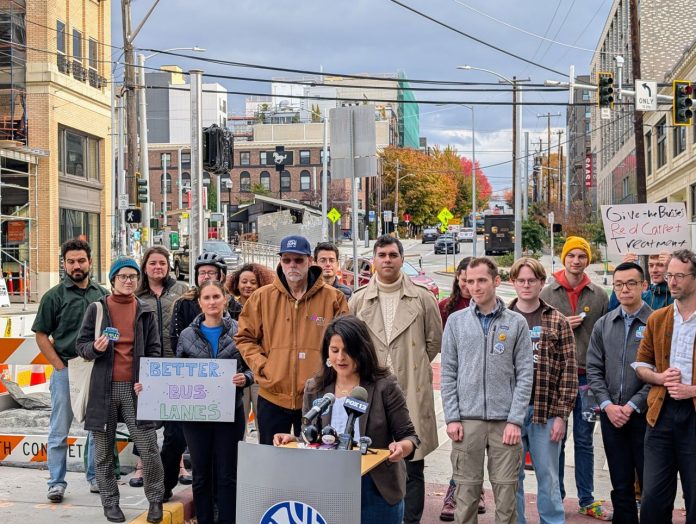
Flanked by a crowd of transit advocates, Seattle Councilmember Alexis Mercedes Rinck announced a “Better Bus Lanes” campaign Wednesday, demanding expanded and improved bus lanes on the city’s busiest transit routes. The press event took place at the site of a recent victory by bus advocates — a new bus lane for Route 2 on Union Street, which was nearly torn out right before it was set to open, until the Seattle Department of Transportation (SDOT) backpedaled due to public outcry.
“Just three weeks ago, the public learned that Seattle Department of Transportation was proposing to remove a block of bus lane right here on East Union Street.” Rinck said. “But riders and advocates mobilized. You showed up, you spoke up. And the message was clear, we need this. Transit matters. The public engagement was so overwhelming that SDOT reversed course. They kept the bus lane and the Route 2 stop, which we’re standing on right now, is slated to open soon. That fight to save the Union Street bus lane wasn’t just about one lane on one street. It was a wake up call. It showed us that there’s real energy, real passion, and real people power behind better transit in Seattle. So today, we’re building on that momentum.”
Among the groups backing the campaign were Transportation Choices Coalition, Amalgamated Transit Union (ATU) 587, Transit Riders Union, Aurora Reimagined Coalition, Fix the L8, and Central Seattle Greenways.
SDOT added the Route 2 bus lane as part of the RapidRide G Line project, which created a bus rapid transit (BRT) corridor along Madison Street. The G Line has attracted big ridership figures thanks to the fast, frequent, reliable service made possible by its own dedicated lanes. Arriving every six minutes, G Line buses served as the backdrop for the announcement of a citywide campaign to improve bus service, along with the 12th Avenue and Union Street bus stop for Route 2.
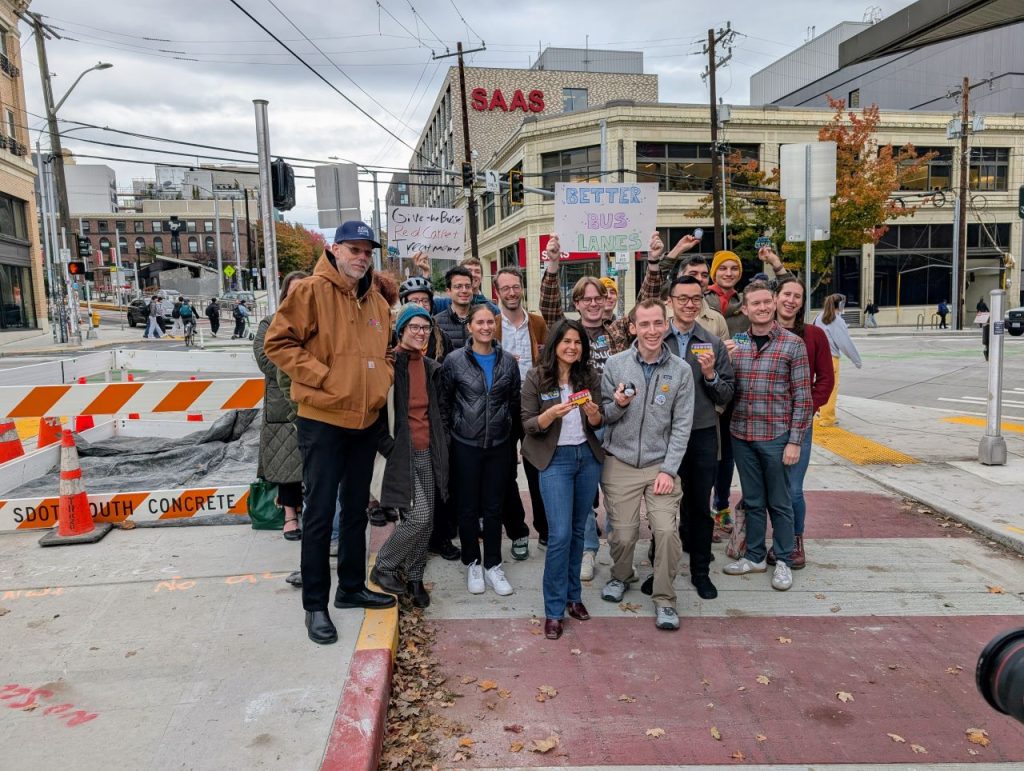
Noah Williams, a member of Seattle Transit Riders Union, pointed to the G Line as emblematic of the benefits many more riders should enjoy on their local routes.
“Transit riders deserve secure, safe, accessible, fast, frequent, rapid transit that meets their needs,” Williams said. “The G Line is a great example of that, and this technology — simple, bus lanes, transit signal priority, hybrid, articulated busses that zoom — is now readily accessible and used around the nation. It is clearly time for Seattle to roll out bus lanes on core corridors throughout them and speed up our busses so that Seattleites can keep moving and not get stuck in traffic.”
Advocates also saw broader societal benefits, like environmental stewardship and social cohesion.
“Busses are the backbone of Seattle’s transportation system,” Rinck said. “They connect our neighborhoods. They get people to work in school. They reduce traffic congestion, cut emissions, and they are the most affordable way to get thousands of our neighbors around town. Busses aren’t just transportation, they’re climate action and community connection. And when our busses work well, our entire city works better.”
The initial focus on the campaign is upgrading Aurora Avenue N, Denny Way, and Rainier Avenue S — key bus arteries and among the deadliest, most crash-prone streets in the city. These streets have long been priorities for transit advocates, but progress has been limited in building out effective bus lanes.
“The better bus lanes campaign today is focused on three of the most critical transit corridors in our city and frankly, in our entire state,” Rinck said. “The E Line, the Route 8, and the Route 7 are some of the busiest bus routes in Washington State. Aurora Avenue is home to our RapidRide E Line, currently the busiest bus route in the entire state of Washington, and we’re calling for permanent 24/7 bus lanes, making the temporary ones we have now a lasting commitment to riders.”
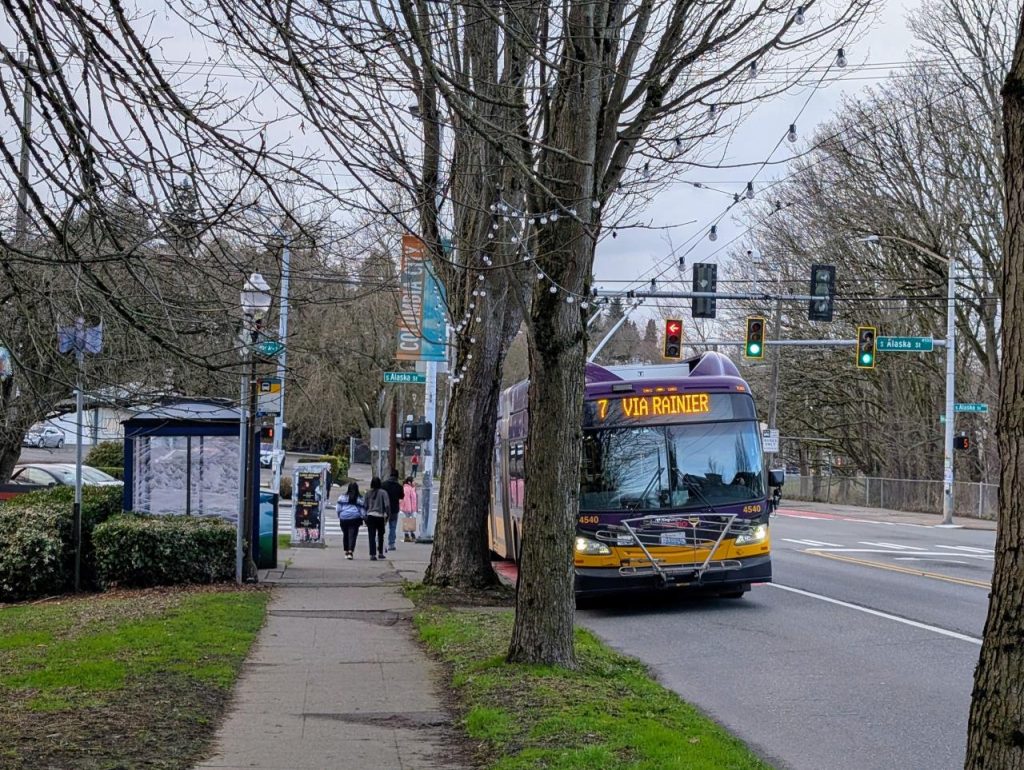
The campaign release stressed that bus lanes would aid in weathering coming transportation network challenge that could bring gridlock: “Bus lanes are a smart, affordable investment that will help Seattleites get around during the World Cup and continued impacts of Revive I-5.”
King County Metro is set to allocate 30,000 service hours in 2026 — funding that could be used to increase bus frequencies on other routes — just to account for additional traffic expected on streets due to the weekslong Revive I-5 highway construction closures. With bus lanes on more routes, those expenditures would likely be a lot less.
Greg Woodfill, president of ATU 587, said bus lanes are essential for buses staying on schedule and improving safety for all road users. He added that bus operators are firmly behind the campaign, and live the frustration of traffic-clogged streets firsthand, as he did in his career as a bus operator. And he noted the irony of RapidRide routes not having sufficient bus lanes.
“I drove when we didn’t have these [bus] lanes,” Woodfill said. “I drove this route too. I would have loved to have this. On Rainier Valley, the Route 7, is an equity issue. I’ve sat in traffic there. I’ve sat up on Aurora. Without dedicated bus lanes, there’s nothing rapid about RapidRide. It’s just taking the number on a bus, changing it to a letter, and changing its color.”
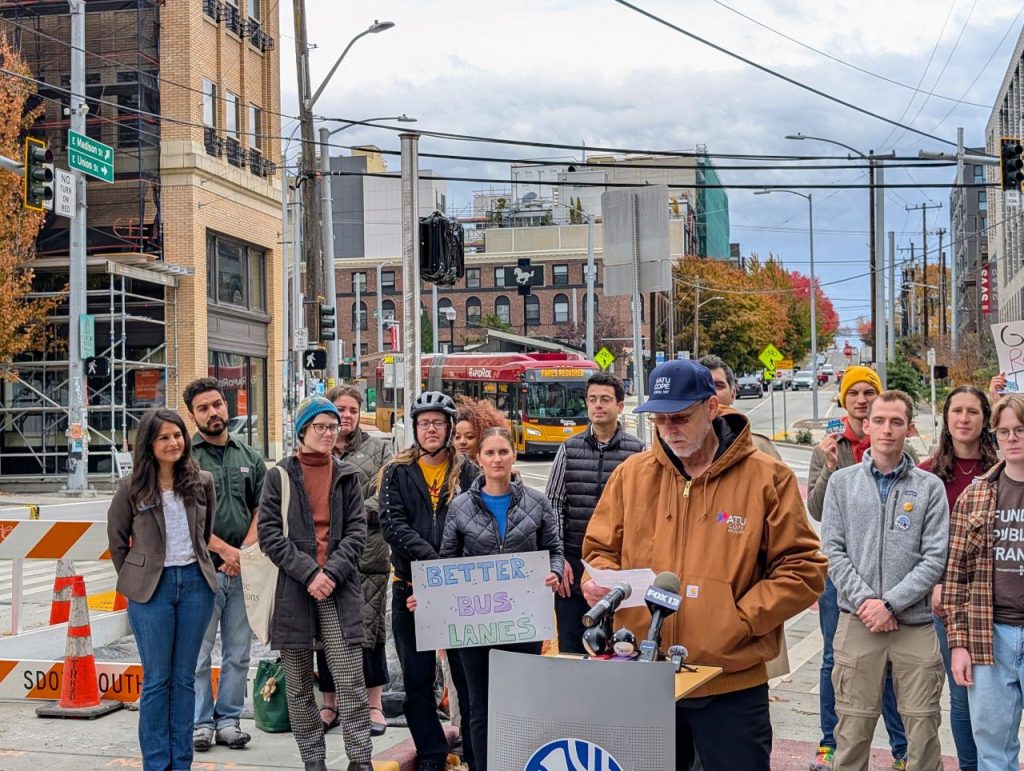
The campaign has suggested focusing Route 7 bus lanes additions in and around Mount Baker, calling for “bus reliability progress on Rainier Avenue in anticipation for RapidRide R around Mount Baker Station while promoting safety for all.” SDOT recently added a northbound stretch of bus lane for Route 7 between Columbia City and Mount Baker, but the bus lane disappears near I-90, where congestion is typically most acute. The 7 is set to become the RapidRide R Line, but that project has suffered consistent delays that illustrate it’s not a major priority for the City of Seattle, with the latest timeline now 2032 with a more meager scope than initially considered.
When it came to Route 8, the Better Bus Lanes campaign has echoed the Fix The L8’s campaign demands, calling for two-way bus lanes on Denny Way from Queen Anne Avenue to Stewart Street. The group recently popularized their bus lane plan with a “Race the L8” event that showed pedestrians could outrace the 8 — even if they were hopscotching, conga-lining, or juggling.
Jason Li, who co-leads the Fix The L8, spoke to the potential that could be unlocked with complete bus lanes on Denny Way.
“Bus lanes can revolutionize a corridor, and we’ve seen it happen before, including with the bus right behind us,” Li said. “Madison Street used to be just like Denny, a chronically congested arterial vital to both local and I-5 traffic, but bus lanes have completely revolutionized the corridor. Now we have replaced over 5,000 cars on our roads with a fleet of 13 buses, and we can do the same on Denny.”
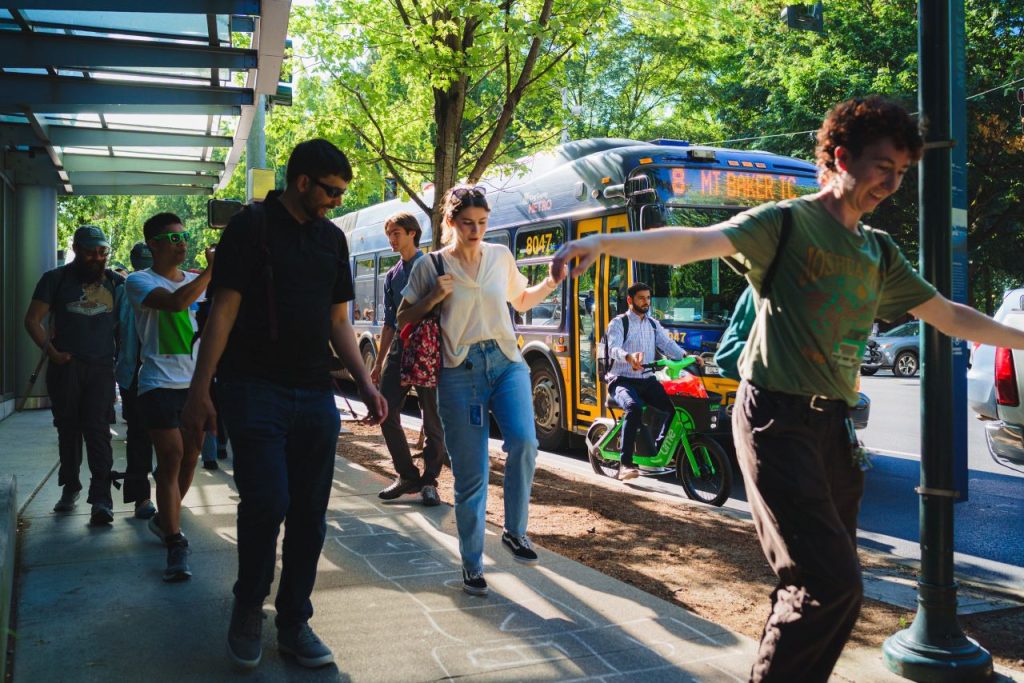
Li sharply rebuked SDOT for ruling out those bus lanes in a traffic study he lambasted as inaccurate and flawed, both in a guest piece in The Urbanist and comments Wednesday.
“Commute Seattle surveys have shown time and time again that the number one reason why people choose to drive over taking transit is because driving is just so much faster,” Li said. “A bus lane would flip this on its head and allow a bus to cross Denny Way from Seattle Center to I-5 in under 10 minutes. That is over twice as fast as driving is today, and it would be sure to convince countless drivers to leave their cars at home and take the bus instead. Because after all, people don’t like sitting in traffic. They don’t like having to find and pay for parking. They only do it because it’s faster.”
That’s not what SDOT’s traffic study found — largely because it discounted the possibility of people not driving, even if congestion worsened massively.
“So it’s easy to imagine a scenario where ridership on Route 8 would double after a bus lane, and that would make Route 8 the highest ridership bus route in the entire state,” Li continued. “But SDOT’s decision to forego bus lanes completely ignores this, because when they did their traffic study on the impacts of a bus lane, they assumed that the number of drivers that would switch to taking the bus after the bus lane is installed would be zero. We know that’s not true.”
The campaign has suggested that SDOT should test out Denny Way bus lanes as a pilot program before ruling out the idea. “Piloting bus lanes along Denny Way allows the city to test new ways to ensure Route 8 can be as reliable as possible on one of our few east-west bus routes.”
Mayor Bruce Harrell’s name went unspoken during the press event, but a mayor’s cooperation will likely prove essential to the campaign meeting its goals, given Seattle’s strong mayor system. In some instances, progress expanding bus lanes has slowed under Harrell, with the City abandoning plans to extend Third Avenue bus lanes into Belltown, impacting 80,000 daily riders.
However, Harrell is facing a formidable challenge from Seattle Transit Riders Union leader Katie Wilson, who led the August primary by nearly 10 points. Wilson has made the need for swifter transit improvements a campaign issue. The Urbanist elections committee (on which I serve as one of 14 members) has endorsed Wilson and Rinck.
As it stands, Rinck has brought forward a Statement of Legislative Intent (SLI) to work with SDOT through the budget process to achieve the campaign’s goals. An ally in the mayor’s office would make the route ahead much smoother.
Safety upgrades
Campaign leaders also stressed safety improvements so bus riders do not have to risk their lives getting to and from bus stops. While a decade ago Seattle adopted a Vision Zero goal of ending traffic deaths by 2030, streets like Aurora and Rainier have continued to be hot spots for deadly crashes.
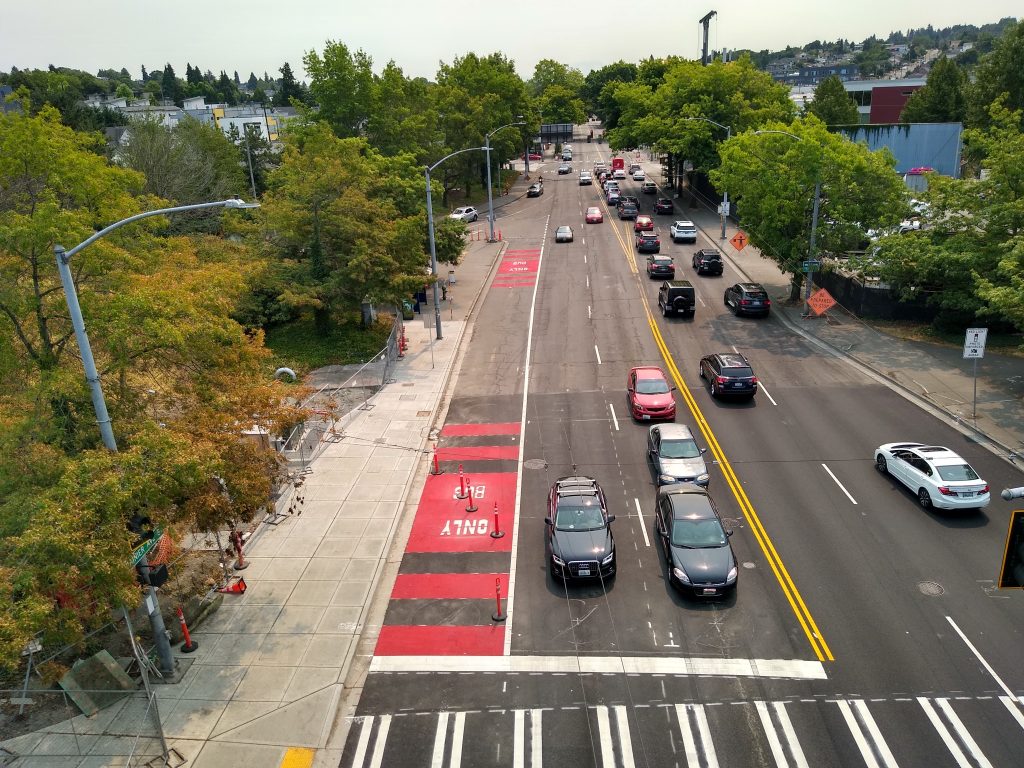
“We need expanded safe crossings, greater access to RapidRide E and automatic speed cameras south of Green Lake to move us toward Vision Zero,” Rinck added. “Aurora is one of our most dangerous streets and comprehensive safety improvements simply can’t wait.”
Carlo Alcantara, with the Aurora Reimagined Coalition, painted some stark traffic safety statistics.
“The RapidRide E line is a critical bus route that we depend on to connect and access our neighborhoods and our homes in North Seattle,” Alcantara said. “It runs primarily along Aurora Avenue N, which consistently ranks as one of Washington’s most dangerous roads. On average, a person is killed by a traffic collision on Aurora every three months, and three people have been killed this year so far. We only have four years left to meet our Vision Zero goals and our commitment to ending traffic deaths on Seattle, but we’re likely to see one more person killed on Aurora this year.”
Despite the terrible safety record, action to change Aurora Avenue has lacked urgency, with the City dragging its feet on a corridor plan despite a state grant to fund the work, with no clear timeline or clearly articulated vision for the road redesign. That lead Alcantara to declare the City was “failing” to reimagine Aurora in an op-ed in The Urbanist this summer.
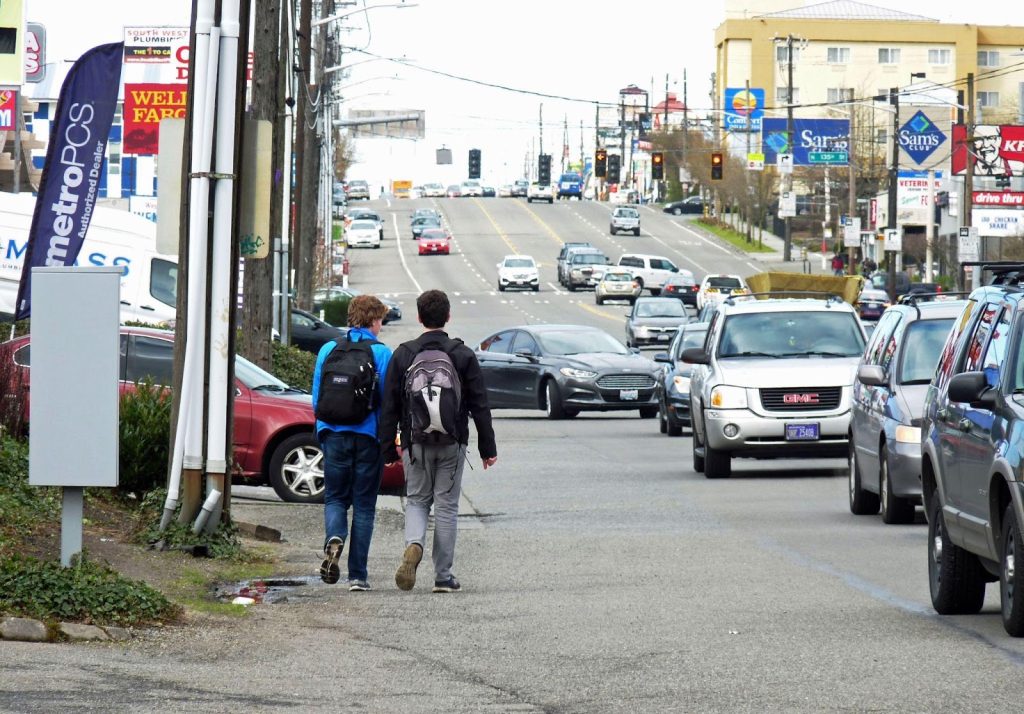
Earlier this year, SDOT added 24/7 bus lanes on Aurora Avenue, but the Harrell Administration framed the change as a temporary intervention during “Revive I-5” freeway maintenance. Advocates are urging the City to make the change permanent and add pedestrian improvements and safety upgrades. Among suggested safety upgrades are automatic speed cameras south of Green Lake, with the state legislature recently explicitly authorizing cities to add speed cameras to state highways that run through their borders.
Funding bus improvements
Transit advocates often point out that the red paint needed to add bus lanes is cheap, but funding the broader corridor upgrades they have in mind may not come cheaply. Kirk Hovenkotter, executive director of Transportation Choices Coalition, pointed out the eight-year $1.55 billion Seattle Transportation Levy passed in 2024 came with a dedicated bus investment fund.
“Seattle’s busiest streets deserve the red carpet treatment,” Hovenkotter said. “Aurora, Rainier, and Denny are three of the busiest transit streets in the entire state. SDOT has already shown how much faster and more reliable busses can be when we prioritize them. We were proud to help lead the passage of the Seattle Transportation Levy, which invests over $150 million into speeding up our busses.”
That might be enough to fund improvements for the three highest priority bus routes, but long-term the broader push for bus upgrades will need dedicated funding — especially in an environment when the Trump Administration has hacked federal transit grants to Blue states close to zero. In fact, Trump has even killed grants that the Biden Administration had already approved, including more than $2 billion for Chicago’s subway and $18 billion for New York rail projects. The federal funding outlook, at least under this anti-transit administration, is bleak.
“Donald Trump is doing everything in his power, and countless things outside of his power, to move us back as a country, including rolling back transit projects,” Li and Sattele said in a joint Fix The L8 statement. “The last thing we need is for SDOT to do the same by tearing out a bus lane. It’s more important than ever that we keep pushing forward as a city, and that includes expanding our bus lanes.”
On the local front, Hovenkotter and Rinck noted that the Seattle Transit Measure renewal, due to be sent to voters next year, could be an opportunity to focus more investment on bus service. That transit measure has traditionally boosted bus service and transit priority investments, though in recent years funding has increasingly shifted to other priorities, like hiring the City’s permitting staff for Sound Transit 3.
Appealing to fiscal prudence, advocates pointed out transit service dollars go much further when busses are not stuck in gridlock, wasting the time of operators and riders alike.
“With all the billions of dollars, both past and future invested on public transit in our region, it’s important that we make decisions and take actions to improve its reliability and flow, not ones that would impede it,” Woodfill said.
For now, riders are left with an increasingly unreliable King County Metro bus network. Bus unreliability has hit a seven-year high, Nick Sattele with Central Seattle Greenways pointed out.
“This summer was the least reliable summer King County Metro has had since 2018,” Sattele said. “The E, 7, and 8, the routes we’re talking about, have the most riders in the city, and they’re the ones pushing that number down. They’re the reason why we have such bad unreliability.”
Doug Trumm is publisher of The Urbanist. An Urbanist writer since 2015, he dreams of pedestrian streets, bus lanes, and a mass-timber building spree to end our housing crisis. He graduated from the Evans School of Public Policy and Governance at the University of Washington in 2019. He lives in Seattle's Fremont neighborhood and loves to explore the city by foot and by bike.

